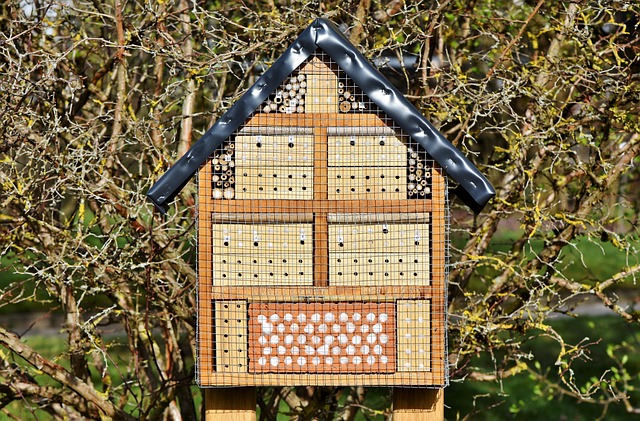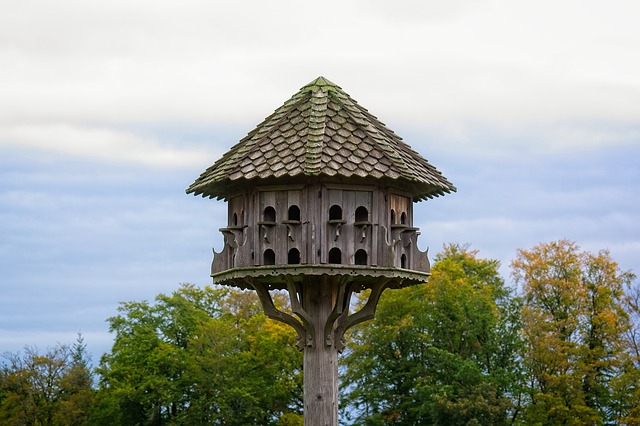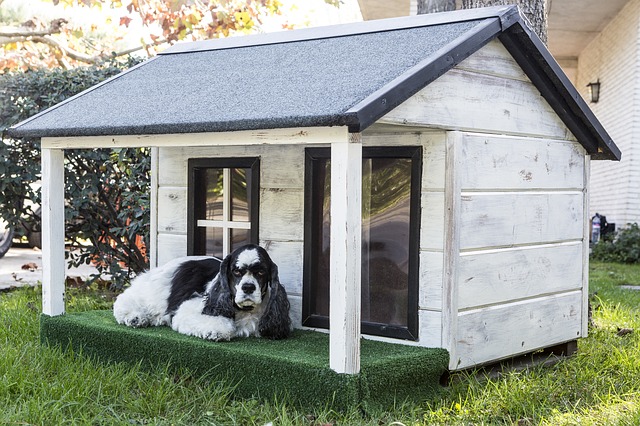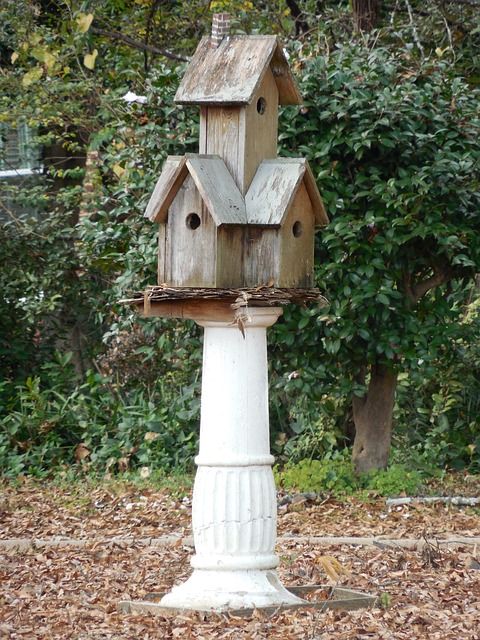Animal Sanctuaries
This is an excerpt from the Book called “Gardenalia“ by Sally Coulthard. Continue reading to learn more about Animal Sanctuaries, thanks to the author.
From chic coops to busy bug boxes, driftwood bird tables to old-fashioned arks, whether you want to attract wildlife into your garden or give your chickens something to crow about, animal sanctuaries have never been so chic.
Insects and bees
While comfort and welfare must top the list when it comes to animal housing, there’s still lots of room for vintage and handmade flair. Even our flying friends can have five-star accommodation. From bug houses to beehives, there are lots of ingenious ways you can bring insect life into your outside space. Wooden beehives cone in different shapes and sizes, thanks to regional and historical variations. From the cottage garden appeal of the WBC hive (The classic beehive shape with the pointed roof that takes its name from its English designer William Broughton Carr) to the flat-topped French Dedant beehive, traditional wooden hives add instant vintage honey-jar appeal to a garden and provide a practical, healthy space fir tour colony. Basket skeps, although pretty to look at aren’t a good option for either bee or keeper, as the only way to harvest the honey is to destroy the colony.
Solitary bees, which act as important pollinators, need a different place to stay. They make their nests in hollow twigs and reeds, or holes in wood, so it’s easy to make your own bee box from untreated wood, old flower stems, short logs, bamboo canes, or redundant bird houses. Either drill holes into a solid chunk of wood or bundle together short lengths of hollow stems or canes and secure with string or a wooden frame. These dinky homes also provide snug, safe bedrooms for other beneficial insects such as spiders, ladybugs, and lacewings. Just remember to put your bug box somewhere warm, dry, and out of wind and rain, or your guests might not make it through the winter. Make more than one box, and place them at different heights around the garden, as different bugs hibernate at different levels.

Boxes and feeders
- You can add a note of whimsy, humor, folk art, homespun charm, or architectural flair with a homemade or vintage bird house.
- An old muffin pan loaded with tasty treats looks charming and will attract grateful flocks.
- A hole and a perch are all that is needed to transform anything into a cozy home—even an old straw hat hung on a sheltered wall.
Birds
Our feathered friends need all the help they can get. Vintage bird boxes and handcrafted huts are an ideal way to encourage wild birds into your garden and will also provide spots of color and visual interest at different heights all year round.
The design of bird boxes has changed little over the last two hundred years, so secondhand and collectible examples will work as effectively as the day they were made. The construction of a simple bird box is also so straightforward that it’s easy to create one from salvaged timber or driftwood. All bird boxes need to be secure and weatherproof, and out of reach of potential predators, but different birds need different houses. The size of the hole at the front of the house will determine what nests there, and open-fronted bird boxes will make cozy homes for robins, wrens and blackbirds. In terms of siting your bird box, make sure it’s at least 5 feet from the ground.
Fix it to a wall or tree, in a quiet corner of your yard. The entrance hole should face anywhere between north and east—this protects the inhabitants from overheating in summer and the worst of the weather in winter. Most wild birds are territorial, too (apart from sparrows, who will happily nest in a community), so don’t place lots of bird boxes next to one another.
And don’t forget to provide an ample supply of food. Vintage bird feeders have become quite collectible–from heart-shaped feeders designed to hold an apple to gazebo/shaped wirework peanut holders, they not only provide a welcome meal for the birds but also add a touch of farm chic to your plot. Almost any salvaged receptacle can be transformed into a feeder if placed at a safe height. From vintage teacups to hubcaps, if you hang it from a tree or prop it on a stand, wild birds will find it and feed.
Pets and chickens
Poultry can be pretty picky. From fancy chicken coops to floating duck houses, there’s a delightful range of traditional and vintage style housing on offer. On a basic level, poultry need somewhere warm, dry, and secure. Chickens also need a perch to sleep on and nesting boxes to lay in. Beyond these simple requirements, it’s more about the owner than the bird, but there’s no reason you can’t create something architectural, whimsical, striking, or rustic to add a flourish to your garden. From Shaker-style houses to converted tool sheds, old dog kennels to mock/villages, practical and pretty chicken huts aren’t mutually exclusive. You can find shepherd’s huts for hens, chicken caravans, and water-side duck pavilions on the Internet, and the fun doesn’t have to stop there. Vintage feeders, old water troughs, and zinc buckets all add to the rustic effect and help keep your henhouse clean and smart. Farm sales and agricultural auctions are a great place to find coops, runs, and duck houses, especially if you want housing on a commercial scale.


Man’s best friend can also get in on the act. They don’t come up very often, but occasionally antique dog kennels and wrought-iron dog enclosures find their way into auctions and salvage yards. Usually commissioned by wealthy owners theses relics—from stone dog kennels to wooden traveling boxes—are often very grand and make smart housing for modern pooches. They don’t come cheap, however. At recent Christie’s auctions in London a late nineteenth-century Victorian oak dog kennel, with a gothi8c-style arched door, an antique French painted wood and gesso dog kennel, made to resemble a stately home, and a small Victorian fruitwood kennel all sold for the price of a small car. Early and mid-twentieth-century examples, however, are easier and cheaper to source and repair if necessary. Most are softwood, and can be prone to rot or woodworm, so check your kennel is safe and comfortable for its new occupant. If in doubt, a traditional-style kit kennel is a good option and can be easily decorated with heritage paint colors for an authentic vintage feel.
When she was a six-year-old girl, Tiffany Kirchner Dixon’s parents escaped the hustle and bustle of California and moved to the Pacific Northwest to buy a farm. From an early age, she was surrounded by fruit trees, vast fields, and farm animals. Fresh milk from the cows, vegetables from the garden, and working the land were all part of daily life. That kind of upbringing is hard to shake. When she was twelve, Tiffany’s father’s job took the family overseas to Hong Kong, a far cry from the bucolic bliss of farm life. Every summer, they returned to the farm and tried to reclaim what the last eleven moths had deprived them of.
Certain that she would become a farmer herself, as an adult Tiffany finally settled upon a gentleman’s farm big enough to house a few horses, her beloved mini burros, pet sheep Margaret, and over forty rare breed chickens. With farming in the blood, along with an inherited passion for all things vintage, it seems inevitable that Tiffany would go on to combine these two passions into a trademark style. As a child, her house was always filled with family heirlooms and characterful pieces, so it’s no surprise that Tiffany picks up her favorite finds in thrift stores, flea markets, and antique shops. Drawn to things out of the ordinary, she’s always ready to repurpose quirky treasures into conversation pieces for the farm.
For the chickens, Tiffany set to work personalizing a basic wooden coop with salvaged materials. Secondhand windows allow light to stream into the coop and make a perfect hatch to keep the chickens safe at night. An old porch door from an early 1900s house, stripped of its screen and replaced with chicken wire, creates an ideal partition to divide the hens from the food storage.
Neighborhood yard sales are a rich seam for Tiffany’s keen-eyed searches and the place she discovered the antique barn ladder that now works as a perch for the hens to reach their nest boxes and roost on at night. Like a magpie, Tiffany always finds herself drawn to galvanized metal, a vintage farm must-have. Not only is the metal charming, but it’s functional, too, and she uses galvanized buckets with locking lids to store feed for the animals. A vintage garbage trolley holds the shiny buckets and makes it easy for her to wheel around the heavy containers. An antique sifter hangs in the coop as a flower pot, and an age-worn armchair allows Tiffany to take a well-earned break after cleaning the coop.
She doesn’t mind that the stuffing is falling out, it only adds to the charm and her handmade feed sack pillow adds extra comfort.
The Fancy Farmgirl
Imagine a farmer who also has a sensational eye for gardenalia. In Seattle, photographer and Fancy Farmgirl blogger Tiffany Kirchner Dixon creates extraordinary chicken coops from quirky collectibles and junkyard materials.


